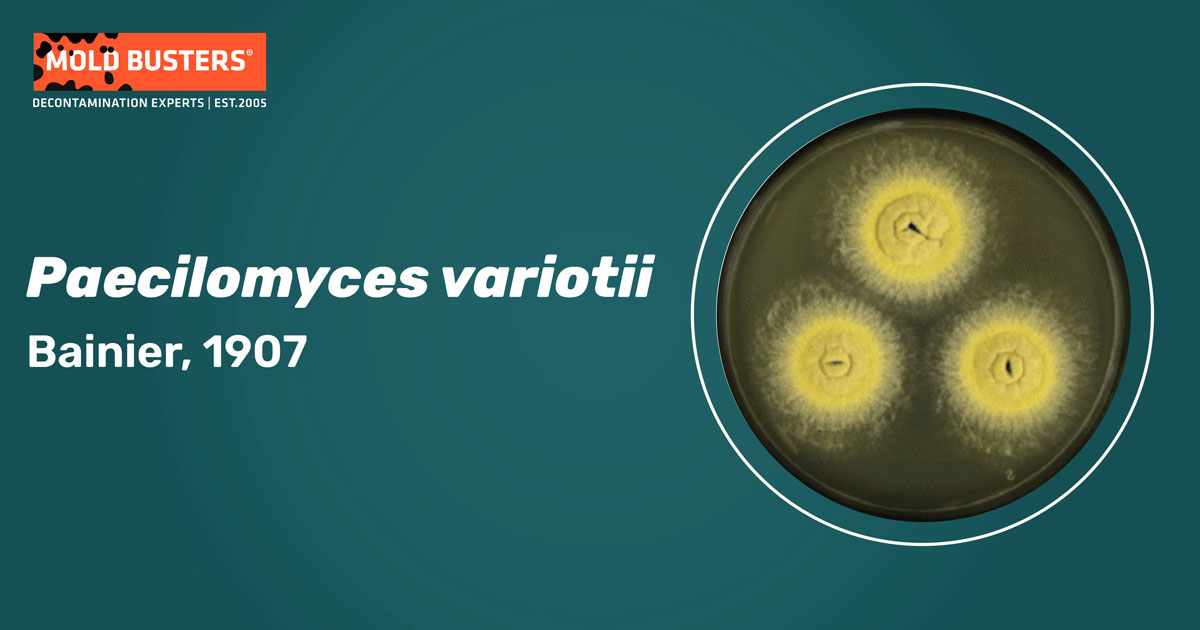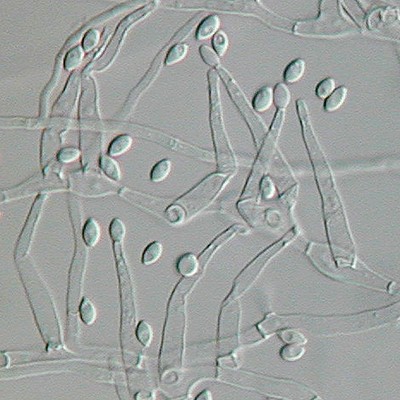Bainier, 1907
What is Paecilomyces variotii?
Paecilomyces variotii is a wide-distributed mold that is readily found in composts and soils and a ubiquitous contaminant of foods and raw materials. It belongs to the genus Paecilomyces, most of which are important as soil fungi and insect pathogens. P. variotii is one of only a few common food contaminants in Paecilomyces species. The genus was split from the Penicillium genus due to morphological differences in conidia and phialides (conidia-bearing structures) (1,2).

Paecilomyces variotii morphology
Paecilomyces variotii has rapidly growing colonies, colored consistently brown to greenish-brown. The colonies are flat, powdery to leathery, and funiculose (rope-like strands) or tufted surfaces. P. variotii colonies are fast-growing and can mature within three days. The conidia-bearing structures consist of loosely branched and irregularly brush-like conidiophores with tapering phialides at the tips. Conidia are single-celled, hyaline, and positioned terminally in chains (Fig. 1).

Figure 1. Paecilomyces variotii under the light microscope (Photo source: Medmyco, Wikipedia).
The species is thermophilic and xerophilic. P. variotii cultures don’t grow below 5 °C (41°F) and can withstand temperatures above 80–100 °C (176–212 °F) only for a short while. Its optimum growing conditions lay between 35–40 °C (95–104°F). It requires 0.8 water substrate activity (aw=0.8) (1).
Paecilomyces variotii ecology
Paecilomyces variotii is thermophilic, growing at temperatures as high as 50–60 °C (122–140 °F) normally. It is also able to withstand short periods at boiling temperatures. This is why this species is a frequent contaminant of food products, especially beverages such as sauces and fruit juices – it can survive pasteurization or other heat-treatments (3).
Another reason why this species is a common contaminant is its resistance to sorbate, which is commonly used as a food preservative. It also is often associated with oily products, such as margarine, edible oils, bacon, coconut, peanut beans, and raw materials containing oil. P. variotii can also be isolated from non-food items such as compost, rubber, glue, urea-formaldehyde foam insulation, and creosote-treated wooden poles (1,3).
Paecilomyces variotii reproduction
Paecilomyces variotii is a heterothallic species, meaning it can reproduce sexually and requires two types of strains (+) and (-) strains to combine to produce the sexual state. Byssochlamys spectabilis is the reported sexual state of P. variotii. Because the ascospores of the sexual state are strongly heat-resistant, it is often that they are the reason for the spoilage of heat-treated food products (3).
Paecilomyces variotii as a human pathogen
Paecilomyces spp. were not viewed as a frequent causative agent of human diseases; however, they are now considered an emerging agent of opportunistic diseases. P. lilacinus and P. variotii are implicated in sporadic reports of serious infections, including most organ systems, and this is especially true for immunocompromised individuals. These two species are morphologically very similar and can be distinguished only by growth rates and spore colors. Interestingly, molecular analyses have shown that these similar species are genetically close and belong to two different orders (2,4,5).
These fungi cause opportunistic mycoses type hyalohyphomycosis (infection caused by non-melanized molds, other than Aspergillus spp. or Penicillium spp.). Paecilomyces are also of clinical interest because of their moderate resistance to antifungal agents. Most cases of Peacilomyces mycoses are involved with immunocompromised patients and are usually cutaneous or catheter-related. However, there are records of infections connected with most organs in the human body. Reported ocular Peacilomyces infections are mostly related to contaminations due to ocular surgeries or prolonged use of eye lenses. Peritonitis (inflammation of the abdomen lining) caused by Peacilomyces spp. is connected with continuous ambulatory peritoneal dialysis (2,4). P. variotii has also been reported to cause sinusitis (inflammation of sinuses) and endophthalmitis (inflammatory condition of the intraocular cavities) (6,7). Wound infection in a transplant recipient and osteomyelitis (bone tissue inflammation) in a patient with the granulomatous disorder as a consequence of P. variotii infection have also been reported (8).
Because P. variotii is commonly found indoors in air samples and dust, carpets, and other textiles, and may be contributing to indoor allergies. It is considered a species characteristic for homes with water damage and is thusly listed in the Group 1 of the ERMI (The Environmental Relative Moldiness Index) list of potentially hazardous fungi (11). P. variotii produces mycotoxin viriditoxin, which potentially has both myotoxic and hemorrhagic activities in animals. Furthermore, viriditoxin is toxic to insects and other microorganisms (9,10).

Did you know?
Chaetomium is the 2nd common toxic mold type found in homes we tested?! Find out more exciting mold stats and facts inside our mold statistics page.
References
- Pitt JI, Hocking AD. Fungi and food spoilage. Vol. 519. Springer; 2009.
- Grossman, C. E. (2005). Paecilomyces: emerging fungal pathogen. Chest, 128(4), 425S.
- Houbraken, J., Varga, J., Rico-Munoz, E., Johnson, S., & Samson, R. A. (2008). Sexual reproduction as the cause of heat resistance in the food spoilage fungus Byssochlamys spectabilis (anamorph Paecilomyces variotii). Applied and Environmental Microbiology, 74(5), 1613-1619.
- Houbraken, J., Verweij, P. E., Rijs, A. J., Borman, A. M., & Samson, R. A. (2010). Identification of Paecilomyces variotii in clinical samples and settings. Journal of Clinical Microbiology, 48(8), 2754-2761.
- Steiner, B., Aquino, V. R., Paz, A. A., Silla, L. M. D. R., Zavascki, A., & Goldani, L. Z. (2013). Paecilomyces variotii as an emergent pathogenic agent of pneumonia. Case reports in infectious diseases, 2013.
- Otčenášek, M., Jirousek, Z., Nožička, Z., & Mencl, K. (1984). Paecilomycosis of the Maxillary Sinus: Paecilomykose der Kieferhöhle. Mycoses, 27(5), 242-251.
- Lam, D. S., Koehler, A. P., Fan, D. S., Cheuk, W., Leung, A. T., & Ng, J. S. (1999). Endogenous fungal endophthalmitis caused by Paecilomyces variotii. Eye, 13(1), 113-116.
- Cohen-Abbo, A., & Edwards, K. M. (1995). Multifocal osteomyelitis caused by Paecilomyces varioti in a patient with chronic granulomatous disease. Infection, 23(1), 55-57.
- Fabiano, R. J., & Tu, A. T. (1981). Purification and biochemical study of viriditoxin, tissue damaging toxin, from prairie rattlesnake venom. Biochemistry, 20(1), 21-27.
- Green, P. E., Blaney, B. J., Moore, C. J., & Connole, M. D. (1989). Identification and preliminary evaluation of viriditoxin, a metabolite of Paecilomyces varioti as an insecticide for sheep blowfly, Lucilia cuprina (Wied.). General and Applied Entomology: The Journal of the Entomological Society of New South Wales, 21, 33-37.
- Vesper, S., McKinstry, C., Haugland, R., Wymer, L., Bradham, K., Ashley, P., … & Friedman, W. (2007). Development of an environmental relative moldiness index for US homes. Journal of Occupational and Environmental Medicine, 49(8), 829-833.
- Featured image photo, Characterization of Paecilomyces variotii and Talaromyces amestolkiae in Korea Based on the Morphological Characteristics and Multigene Phylogenetic Analyses – Scientific Figure on ResearchGate.

Get Special Gift: Industry-Standard Mold Removal Guidelines
Download the industry-standard guidelines that Mold Busters use in their own mold removal services, including news, tips and special offers:

Written by:
Dusan Sadikovic
Mycologist – MSc, PhD
Mold Busters
Fact checked by:
Michael Golubev
General Manager
Mold Busters
